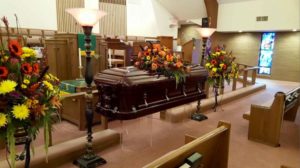
Martha Peterson funeral 2016
*On this date in 2016, the funeral of Martha Peterson, a Black woman, occurred at Saint Mark’s African Methodist Episcopal Church in the Jackson Heights neighborhood of Queens. This episode was unique because Peterson was born in the 19th century.
On Oct. 4, 2011, construction workers were using a backhoe to clear soil from an abandoned lot in the Elmhurst neighborhood of Queens, New York City. They uncovered a woman's body at the site, dressed in a long white nightgown with knee-high socks and a comb with a knit cap on her head. Forensic archaeologist Scott Warnasch of the city's Office of the Chief Medical Examiner was called in to examine the human remains of what was assumed to be a victim of a recent homicide. Before viewing the corpse, his archaeological team arrived on the scene and spotted distinctive chunks of rusty metal in the dirt that he recognized as fragments of a cast-iron coffin. Warnash said, "Just from that, I knew that this meant we were dealing with an archaeological discovery circa 1850," "This was not a crime scene."
The well-preserved body was that of a young black woman who died before the American Civil War in the first half of the 19th century, although she appeared to have only been dead for about a week. She was buried in an elaborate and expensive metal casket on the property of what was once an African Methodist Episcopal church. The city office believed her to be Martha Peterson, who worked for a white man who was a partner of the iron coffin creator.
The first cast-iron coffin was created and patented in 1848 by Almond Dunbar Fisk, a stove manufacturer from New York. The so-called Fisk metallic burial cases were custom-formed to the deceased's body, styled after an Egyptian sarcophagus, and featured a small window over the face for viewing. The airtight caskets were designed to naturally preserve the remains of individuals who died far from home and needed to be sanitarily transported to a distant funeral before embalming or refrigeration. The iron coffins could also quarantine a body infected with cholera or another contagious disease. Fisk's coffins became popular among affluent families in the mid-19th century, so he increased production and established the now-defunct Fisk & Raymond Company with his brother-in-law, William Raymond.
The New York City Landmarks Preservation Commission that the abandoned site in Elmhurst, formerly known as Newtown, was previously the location of a church founded by the community's first generation of free Africans in America, not long after New York State had officially abolished slavery. As the forensic team recovered the woman's body, they noticed lesions on her skin that suggested she may have succumbed to smallpox, and they worried the virus could still lurk in her corpse. So, they contacted researchers at the Centers for Disease Control and Prevention, who tested multiple specimens from the body and confirmed there was no live virus.
She must have died between 1848 and 1854 based on that age range and the years that the Fisk iron coffins were made. Assuming she had lived in the area where she was buried, the forensic team started searching through an 1850 census report, which was the first year to list everyone in the New York population by name, age, sex, and race. He found 33 individuals who fit the woman's criteria. Warnasch said, "One name stuck out in particular: Martha Peterson." The census report noted that Martha Peterson was 26 years old in 1850 and lived in the household of William Raymond, the brother-in-law, neighbor, and business partner of the iron coffin maker.

It is assumed that Peterson worked for him as a domestic servant. "That's as close to a smoking gun as you can get for the early 19th century," the archaeologist said. Warnasch also learned that Peterson was the daughter of John and Jane Peterson, prominent figures in Newtown’s African American community. It was not immediately known whether Peterson had any living descendants, but that's something Warnasch said he hopes to continue investigating.
Because the backhoe had badly damaged Peterson's skull, the expertise of a forensic-imaging specialist was used to create a digital reconstruction of the woman's face (above) so they could get a sense of what she may have looked like. A CT scan from Peterson's autopsy was used to digitally fix the damaged parts of her skull. He also incorporated age and ancestry-appropriate features from a database and, based on her race, gave her brown eyes and a medium-dark complexion to complete the image. Peterson was buried at Mt. Olivet Cemetery in the Jackson Heights neighborhood of Queens the following day.